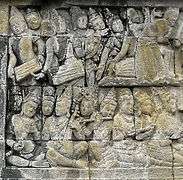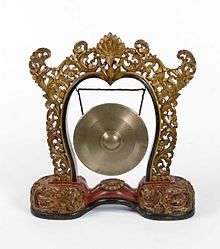Irama

"Irama" is the term used for tempo in gamelan. It can be used with elaborating instruments. It is a concept used in Javanese gamelan music,[2] describing melodic tempo and relationships in density between the balungan, elaborating instruments, and gong structure.[3] It is distinct from tempo (Javanese: Laya), as each Irama can be played in different tempi.[4][5] Irama thus combines "the rate of temporal flow and temporal density"; and the temporal density is the primary factor.[6]
One way to think of Irama is to use the most consistently struck instrument in the gamelan, the saron panerus (or peking). In some pieces, it plays once per note in the balungan (such as played by the saron barung). In others, it may play twice as often, or four times, as the notes of the balungan are more spread out. This corresponds to a slower Irama. In most cases, the more spread out the balungan is, the longer it takes to reach a gong ageng.[7]
There are five Irama:[2]
| Irama number | Irama name | Saron panerus beats per balungan note |
|---|---|---|
| 1/2 | Irama lancar | 1 |
| I | Irama tanggung | 2 |
| II | Irama dados (or dadi) | 4 |
| III | Irama wilet | 8 |
| IV | Irama rangkep | 16 |
In slower Irama, there is more space to be filled, and typically elaborating instruments become more important.
Each Irama can be played in three Laya ("tempi"):
- Seseg ("fast"),
- Sedeng ("medium")
- Tamban ("slow").
Frequently, a change of Laya signals a new section.
Bibliography
References
- ↑ Lindsay, Jennifer (1992). Javanese Gamelan, p.54. ISBN 0-19-588582-1.
- 1 2 Peeters, Geoffroy. "The Javanese Gamelan". The Javanese Gamelan. Retrieved December 5, 2011.
- ↑ Spiller, 2004.
- ↑ Sumarsam (2008). "Gamelan of Central Java". Gamelan of Central Java – XII. PANGKUR ONE. Yantra Productions (gamelan.to). Retrieved December 5, 2011.
- ↑ Jordan, Bern (May 25, 2002). "Javanese Gamelan". Javanese Gamelan: Glossary. Retrieved December 5, 2011.
- ↑ Sumarsan, 1996. page 156
- ↑ Guberman, Daniel. "Gamelan Nyai Saraswati". Introduction to the Peking. University of North Carolina. Retrieved December 5, 2011.

